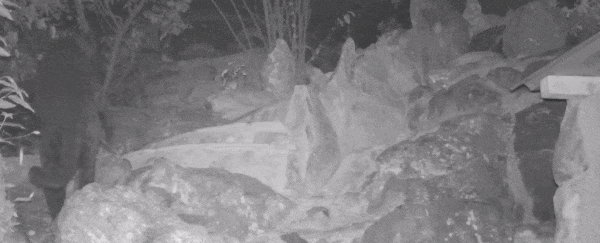On shadowy paws in the dark of the night, the rare black leopard is rarely seen by human eyes. But now its breathtaking beauty has been captured in exquisite detail, thanks to trail cams and camera traps set up in Laikipia County in Kenya.
San Diego Zoo caught the gorgeous animal on remote video cameras set up to try and understand the population dynamics of leopards in the region.
"Regionally we've heard reports of black leopards living here in Kenya, but high-quality footage or imagery to support these observations has always been missing," said carnivore biologist Nicholas Pilfold of San Diego Zoo Global.
"That's what we've provided here with our cameras, and now we're able to confirm what has been long suspected about black leopards living in Laikipia County."
Black leopards, also known as black panthers, are not a separate species. They are regular leopards (Panthera pardus) with a condition called melanism, in which their bodies produce a higher-than-usual amount of dark pigment. This makes their fur appear black - but they still have 'ghost' spots that can be clearly seen underneath the sleek dark coat in infrared light.
The effect is a glorious one, but it's poorly understood. That is, we know how it happens - but we don't know if there's a reason why.
Scientists have ascertained that melanism in leopards occurs more frequently in forested areas, where perhaps a darker coat means greater camouflage. Melanism has also been linked to a greater immune response in other species, so it's possible that the condition confers several benefits.
But the Laikipia Plateau is not densely forested - its wilderness is open plains.
"Elders in my community had told me about black leopards being common in the Laikipia Plateau," said Ambrose Letoluai, research assistant for the leopard conservation program and Loisaba Conservancy.
"It's exciting to see black leopards on our cameras - and more research into their melanism is needed, so we can understand why they occur here."
But the footage, exciting as it is, wasn't all. Nature photographer Will Burrard-Lucas had also heard reports of a black panther in the area, so he headed over to try and capture it on camera.
After finding what seemed like a high-traffic leopard path, he set up a number of camera traps, each consisting of a motion sensor, a high-resolution DSLR camera and several flashes.
He left the cameras for several nights to do their job.
"On returning, I checked them and by the time I got to the last camera, all I had seen were pictures of hyenas but no leopards," he recounted on his blog.
"I had a quick look at the last trap, not expecting to find much. As I scrolled through the images on the back of the camera, I paused and peered at the photograph below in incomprehension… a pair of eyes surrounded by inky darkness… a black leopard!"
Here are more of my black leopard photos. What a stunning animal! I have shared a few more on instagram as well https://t.co/JNNq5eJ035 pic.twitter.com/cQAQPFQd6N
— Will Burrard-Lucas (@willbl) February 13, 2019
Although sighting and even photographs of black leopards are absolutely not unheard of in Africa - contrary to claims that this sighting represents the first in over 100 years - they are relatively rare compared to their golden siblings.
Burrard-Lucas' photographs represent some of the best-quality images ever taken of black leopards in the wild in Africa - and they may help unravel the mystery of why some leopards are gloriously black.
A paper from the San Diego Zoo Global team appears in the African Journal of Ecology.
